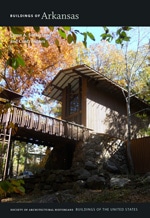This house was built by banker and businessman Bruce Sutton, who with his family fled to Texas for the duration of the Civil War, returning to find his house damaged and his hoarded Confederate money worthless. In 1882, William H. H. Clayton and his wife, Florence, purchased the neglected house and restored and enlarged it, adding its north portion in the same style as the original. The two-and-a-half-story house has a one-story porch across the facade, a bay window, clipped gables at the roofline, and Italianate details such as paired wooden brackets, ornate hood molds, and slender cast-iron columns on the porch. Interior wood finish is largely yellow pine and painted, an exception being the main stair-case railing and elaborate newel post of black walnut. Clayton was one of four brothers from Pennsylvania, among whom was Powell Clayton, a founding developer of Eureka Springs. William H. H. Clayton was appointed U.S. district attorney for the Western District of Arkansas by President Ulysses S. Grant. In 1969, the Fort Smith Heritage Foundation acquired the house in order to prevent its demolition and led its renovation. It is now a house museum.
You are here
William H. H. and Florence Clayton House (Sutton House)
If SAH Archipedia has been useful to you, please consider supporting it.
SAH Archipedia tells the story of the United States through its buildings, landscapes, and cities. This freely available resource empowers the public with authoritative knowledge that deepens their understanding and appreciation of the built environment. But the Society of Architectural Historians, which created SAH Archipedia with University of Virginia Press, needs your support to maintain the high-caliber research, writing, photography, cartography, editing, design, and programming that make SAH Archipedia a trusted online resource available to all who value the history of place, heritage tourism, and learning.















